|

Welcome Rarities
JAMES SOHRE enjoyed his visit
to Wexford Festival Opera
Before a note sounded at Wexford Festival Opera, the Minister for the Arts, Heritage and the Gaeltacht got the season off to a rousing start by announcing that the venue had been designated henceforth as 'Ireland's National Opera House'.
After cheering that news to the rafters, we settled in so the industrious company could show just how they helped facilitate that honor by doing what they do best: explore little-known works of lyric theatre and present them in fully-staged professional productions with exciting young singing stars and a festival quality orchestra. In a world where opera companies shy far, far away from including even one such rarity in a season weighted with bankable 'Top Ten Favorites', Wexford has celebrated sixty-three remarkable years triumphantly doing exactly the opposite. Wexford Festival Opera is surely an opera enthusiast's indispensable resource.
A gala opening night found the troupe in stellar form with Antoine Mariotte's setting of Oscar Wilde's Salomé. The composer studied with d'Indy, and he was clearly influenced by Massenet and Debussy. It was intriguing to see Mariotte select other sections and slants from the source of Wilde's play, that was also famously set by Richard Strauss. Here, characters are less eccentric, less sexed-up, but with a complex, almost neurotic emotional intensity. The sound palette is more muted, less bombastic. Among the unique musical effects is a brooding wordless chorus that provides an eerie under-pinning for Salomé's paean to Iokanaan's severed head.
The score was written in one act of seven tableaux, but Wexford inserted an intermission after scene three, which detracted from the work's inexorable build of tension and interrupted the accumulation of musical motifs. I guess the opening night glitterati required a chance to sip champagne and mingle, but the show would be better served up as a unified whole.
The orchestra played evocatively under David Angus' assured baton. The players brought a mesmerizing, languorous beauty to the restless, churning, overlapping phrases that inform much of the score. But the Maestro also elicited conviction and fire when required, and the winds contributed atmospheric playing both singly and in ensemble.
Rosetta Cucchi's direction was wholly competent if lacking in real specificity in the interaction between the principles. Certain turbulent orchestral passages suggest movement, or at least psychological turmoil, but neither was always realized visually. Cucchi weighted the piece with a concept that was consistent if it occasionally strained to make its effect. It revolves around the number seven: Seven deadly sins, seven veils, seven supernumerary kings, and even seven receding stone arches in a forced perspective, compliments of set designer Tiziano Santi.
Santi has provided an ideal playing environment for the biblical debauchery, and DM Wood contributed a fantastical lighting design that heightened the effect. The act curtain is a scrim painted to resemble a lavish middle eastern carpet, and indeed there were effective uses of scrims and flown walls throughout the night. The cistern is defined by a primitive rocky mound encircling a hole dead center stage.
When the imprisoned prophet is first revealed, he is chained at the foot of a stone staircase upstage, which is meant to be a 'reveal' of what is down the hole. Later, after he is felled, the same upstage reveal contains a decapitated, bloody corpse chillingly splayed on the steps. There was a very clever piece of business when the heroine drops a flower down the cistern center, and a coordinated flower falls from the flies on the cistern stairs pictured up stage.
Another fine effect was the claustrophobic wall flown in mid-stage with two cramped doorways that framed the two soldiers as they desperately urged Salomé not to insist on the beheading. The crumbling and breaking of the arches as the drama careens to its conclusion was also a telling psychological effect.
Claudia Pernigotti devised an array of costumes that were by turns apt, colorful, bestial and biblical. Salomé was encased in a glittering pale patterned body stocking, with an overdress draped invitingly about her torso. I wish she had not been made to 'bare her breasts' to try to shock Iokanaan, since it diluted the impact of the more important moments in the dance.
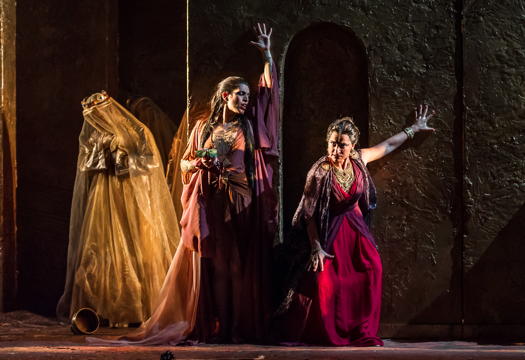
Na'ama Goldman and Nora Sourouzian in Antoine Mariotte's 'Salomé' at Wexford Festival Opera. Photo © 2014 Clive Barda. Click on the image for higher resolution
|
The prophet looked imposing in his lounge pants and long white jacket not always covering his bare chest. For once, he was not some repellent ascetic, but rather someone with some physical desirability. The 'seven kings' were draped in lavish voluminous, diaphanous gold capes, masked and crowned. Their presence certainly dazzled even while their plot function as symbols was muddying. Speaking of mud (and I was), why do three of them smear the prophet's white coat and hair with gray mud as Salomé sings of his beauty? The rest of the attire was character specific and the soldiers sported appropriately barbaric gear, but the Hannibal Lecter-like masks served to distance them from the audience.
The dance was imaginatively choreographed by Vittorio Colella, and it was projected live to the top half of a drop/screen. The projection made it even larger than life, and the simple but effective disposal of the veils finished with each one neutralizing a spectator-king, sort of 'vaporizing' him to the ground.
The Page was made to spend the first 'half' far down right, obsessing on a golden robe that was left over from an effective pantomime 'teaser' during the prelude, which established Salomé as a carnal creature in the center of an orgy with the seven robed kings. After the interval, the Page spent the rest of the piece mutely obsessing on a crown.
Speaking of crowns (and I was): Salomé isn't killed as Hérode directs. Rather, she collects the crowns of the veiled-to-death kings that are strewn upstage, and adds them to the 'head', which is actually only a simple bloody circular metal crown that represents Iokanaan's 'tête'. As she settles in hoarding her collection in front of the cistern, the dazed Page staggers to give her the final crown that (s)he has caressed for forty-five minutes. Things that make you go 'hmm'. Not bad, but ... hmm.
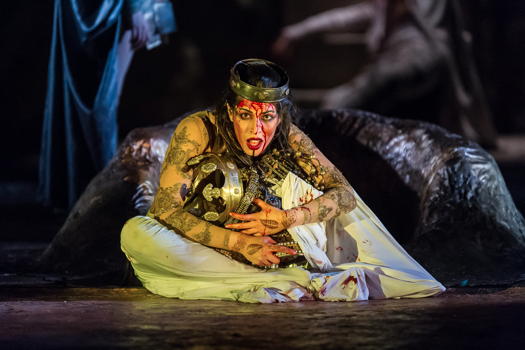
Na'ama Goldman in the title role of Antoine Mariotte's 'Salomé' at Wexford Festival Opera. Photo © 2014 Clive Barda. Click on the image for higher resolution
|
From what I can glean, the title role was written for a soprano but is assumed here by a highly talented mezzo, Na'ama Goldman. The outcome is that her sizable instrument cuts through the occasional dense orchestral stretches like a gleaming knife through hot butter. The downside is that Goldman's vibrantly rich tonal production sounds a bit mature in the opening pages, and she doesn't quite vocally suggest the young princess. She looks lovely and commands the role, but it is when the piece finally moves into more lurid considerations, that Na'ama successfully moves from being a competent juvenile to being a memorable young woman. She is a lively and committed actress but I would advise that she be careful of too many grimaces and mugs that threaten to cross over into the wide-eyed camping that served Gloria Swanson well in Sunset Boulevard. There is more to be done with less, and development of subtext would make for a more layered performance.
My major discovery of the evening was baritone Igor Golovatenko as Iokanaan. Although his off-stage lines could have benefitted from some amp reverb to suggest the cistern, once he was in full view, his world-class instrument went from strength to strength. None of the score's imposing vocal demands eluded him. Golavatenko not only has the virile, buzzy power for the pontificating statements, but also has a welcome ability to begin top notes mezzo forte and then effortlessly swell them to great dramatic effect. His impressive vocal alignment never faltered and his nuanced reading was a considerable asset.
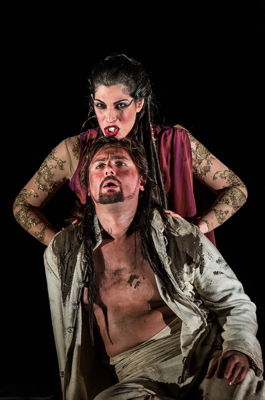
Na'ama Goldman and Igor Golovantenko in Antoine Mariotte's 'Salomé' at Wexford Festival Opera. Photo © 2014 Clive Barda. Click on the image for higher resolution
|
Scott Wilde's Hérode was no less accomplished. We are so used to a character tenor in the 'other' version, that it is a delightful change of pace to have a superlative bass-baritone who really, beautifully sings the role. No mere comprimario he, Scott deployed his well-schooled voice to discover many subtleties in a role that seems on first hearing, under-written. As Herodias, the potent Nora Sourouzian seemed to be channeling Fricka, her searing, full-bodied mezzo ringing out commands and exhortations like a Wagnerian schoolmarm-who-must-be-obeyed.
The Young Syrian (read: Narraboth) was taken by The Young Eamonn Mulhall, who gave much pleasure with his clear-toned, brilliant, and supple tenor. He memorably negotiated the naïve lad's high lying phrases, and created a sympathetic character as he suffered from utter devotion to the calculating princess. As the Page, Emma Watkinson's tone started off a little bit diffuse but quickly focused up to add pointed interjections and important commentary on the moon as the action proceeded. The two soldiers Nicholas Morris and Jorge Navarro-Colorado showed off polished, forceful vocalizing even as they embodied unpolished, frat boy bad behavior.
For Antonio Cagnoni's comic Don Bucefalo, director Kevin Newbury had a much more accessible concept in mind, for inspiration drawing on two American classics, The Music Man and the cinematic send-up of backstage machinations at community theatre, Waiting for Guffman. Since the plot loosely involves a con man (Don Bucefalo) posing as a music teacher who ingratiates himself to the community and, especially, the leading lady, Newbury found great resonance in the comparison, and mined endless comic situations from what is essentially a one-joke evening.
The action was set in designer Victoria (Vita) Tzykun's version of a nineties American all-purpose community center, sort of a gym-a-torium with basketball court, workout areas, day lockers, and well, you get the idea. Tzykun's set is a marvel of invention, what with the upper office, the 'stage' and its curtain/drops, the daffy theatrical props (flowers, cut-out clouds that upend to 'rain' tinsel, etc) and ladders of various sorts. While the overall look is worn and drab, the environment pulses with life, not least owing to the clever, supposedly 'improvisatory' lighting by DM Wood. The rolling practical period spotlights are particularly well-used when the heroine (and others) dream of their moment in the limelight of fame.
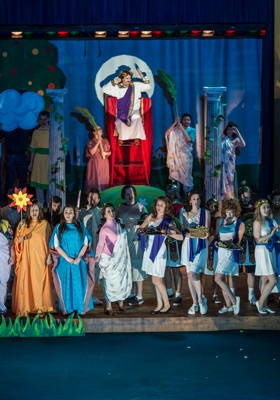
The cast of Antonio Cagnoni's 'Don Bucefalo' at Wexford Festival Opera. Photo © 2014 Clive Barda. Click on the image for higher resolution
|
Jessica Jahn's riotous costumes were wildly colorful and a veritable grab bag of types: community theatre aspirants that included local 'favorites' as well as 'also-ran's. Leading lady Rosa was a buttoned up office worker, rival Agata a loose-limbed Jazzercize class leader. The Don was a suave manipulator, the Baron a white-suited out-take from Saturday Night Fever.
While Newbury used every inch of the stage, creating memorable interplay and an impressive variety of stage pictures, he was ably partnered by Paula O'Reilly, who concocted clever choreography-for-the-non-dancer that was suitably Guffman-esque. (It would not have been out of place in that film's number, 'Stools'.) Newbury expertly kept re-inventing the conceit of rank amateurs seeking to rise above their station and skill level to musical/theatrical fame. In this day and age of reality talent contests, this is certainly not much of a stretch!
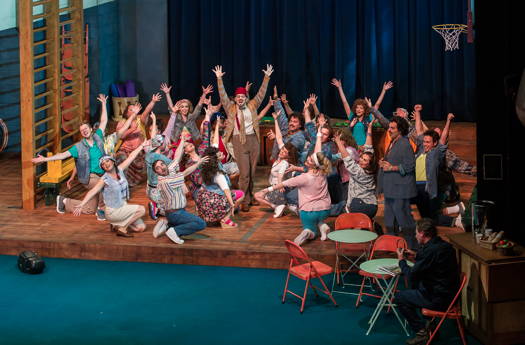
A scene from Antonio Cagnoni's 'Don Bucefalo' at Wexford Festival Opera. Photo © 2014 Clive Barda. Click on the image for higher resolution
|
All manner of 'found' props were incorporated into the staging, as effectively and exhaustively as in the celebrated Susan Stroman staging of the classic 'I Got Rhythm' number where she includes every possible prop you can think of, and several that you can't. A simple basketball figures especially persistently and prominently. And, well, if every single line of text does not ring true (estranged husband Carlino's saying of the hall, 'This is my house', for example), well, who cares when we are having this much damn fun?
The musical preparation and execution could not have been bettered with Sergio Alapont leading an assured, propulsive, ebullient reading that cascaded off the page and tickled the ear with richly detailed, incisive comic force. Maestro Alapont's consummate skill was that he could turn on a dime and establish sudden new tempi 'en masse' with the balancing skill of an air traffic controller. Also, he was highly adept at partnering his soloists whether in limpid moments of respite from the general madness, in rapid flights of coloratura, or in (sometimes over-extended) cadenzas that never lost forward direction. There are patter sections in the piece that rival the very best Rossini, and Alapont led them with exacting control. The overall shape of the opus was a satisfying build of tension and humor from beginning to end, making Don Bucefalo one of the best musical comedy evenings I have spent in Wexford. Oh hell, make that 'in the world'.
In the title role Filippo Fontana gave a tour de force comedic performance that anchored the show, as it must. As an actor, Fontana proved as endearing and ingenious as Academy Award winner Roberto Benigni, and his manic energy never flagged. His reliable bass-baritone is more baritone than bass, with the very lowest notes touched on but not reveled in. His delivery has good ping and his technique is secure. Top notes command attention even while, overall, the voice is a bit dry. Still, he knows exactly how to make every moment count and his 'leading of the orchestra' as he conducts the overture he has 'composed' simultaneously singing nonsense instrumental riffs was one of the evening's uproarious highlights.
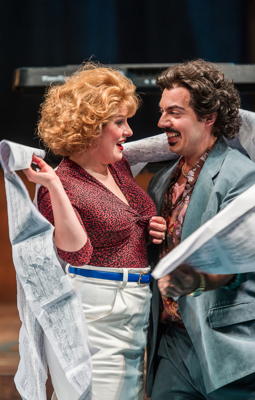
Marie-Ève Munger and Filippo Fontana in Antonio Cagnoni's 'Don Bucefalo' at Wexford Festival Opera. Photo © 2014 Clive Barda. Click on the image for higher resolution
|
I quite warmed to Marie-Eve Munger's Rosa, although at first the placement was somewhat variable. In her opening scene the segments 'in alt' were reliable but somewhat detached from the upper middle by affectation of a slightly veiled approach. As the evening progressed, the tone assumed more and more silver, and she gave much pleasure with not only honeyed legato, but also with accurate and high-flying fioratura. The couple of very tippy-top notes (verging on pitches only dogs can hear) might be advisably adjusted downward since they tended to splay. But overall, hers was a commendable performance of a very, very 'Big Sing'.
Matthew Newlin proved an amusing and warm-voiced Count di Belprato. There is not a doubt he could excel as any number of romantic operatic heroes, and here his melting, warm tone and easy vocal production were a thing of beauty, indeed. What was even more laudable was his uncommonly easy stage presence and his enthusiastic embrace of even the most outrageous stage business. Agata has few moments to shine but when given a momentary turn in those spotlights, Jennifer Davis really rose to the occasion and put her rich, beautifully modulated soprano to fine use in a melting aria that was all too brief (but roundly cheered).
Don Marco has the unenviable task of being the 'other (lesser) buffo' in the work, and his function is more straight man than comic. Davide Bartolucci was uncomplicated and incisive in the role, and succeeded in establishing a real vocal personality. As Carlino, tenor Peter Davoren was solid and assertive, sometimes a bit too much so when the odd high note got bullied into submission. It is hard to over-praise Errol Girdlestone's superb chorus who not only sang with clarity, enthusiasm and stylistic accuracy, but did it all while executing demanding staging and maintaining unique characterizations. If pride of place is to be awarded in this winning production, the chorus would certainly be considered the delectable icing on a very rich cake.
For Silent Night, designer Erhard Rom erected a massive three-tiered set with very few other pieces, allowing the soldiers and other actors to 'decorate' the spaces, grouped by nationality. This edifice was augmented with carefully selected drops and meaningful projections that were incorporated into the flawless lighting design by the ubiquitous DM Wood. Simplicity of presentation was the key, as was clarity of the multiple characters and their relationships to each other. To that end, Tomer Zvulun's assured direction used economy of movement, isolation of areas, and layered uses of scrims. In one brilliant directorial stroke, I was suitably startled by the house lights coming on suddenly to announce the commencement of wartime hostilities, interrupting the duet being performed onstage at the Berlin Opera, and setting the perfect tone for all that follows.
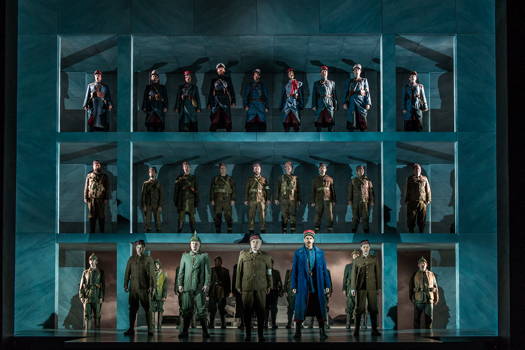
The cast of Kevin Puts' 'Silent Night' at Wexford Festival Opera. Photo © 2014 Clive Barda. Click on the image for higher resolution
|
The orchestra once again played magnificently from first to last, helmed with inspiration by Michael Christie. The writing is exceptionally diverse and encompasses an impressive array of effects: classical opera, atonality, neo-romanticism, folk tunes, you name it and it is probably there. The detailed instrumentation includes a luminous onstage string quartet, and the haunting sounds of a bagpipe among its satisfying aural effects. Even during times of relative calm, the piece had a restless, unnerving undertone. The dramatic writing is exceedingly clever, entwining three languages and making the whole experience truly universal. The German was not always 'echt', and the French was sometimes approximated but the earnest effort was commendable.
On first hearing, I questioned the wisdom of occasional vocal writing in extreme, uncomfortably high ranges for the two German lovers. The composer clearly wants this effortful effect but I wonder if a lower, more singer friendly option might not pay bigger dividends? That said, the singers were uniformly accomplished at their tasks.
The delightful Quirijn de Lang as French soldier Ponchel luxuriated in an attractive, easy baritone that ably complemented the opera's most sympathethic role. Clearly, his death was calculated for sentimental effect and it landed beautifully. As the German opera-star-turned-soldier, Nikolaus Sprink, Chad Johnson was tireless in his outpouring of clean, lean, clear tone. His love interest, Anna Sørensen was well taken by Sinéad Mulhern, even if she sometimes had to push her throbbing tone and secure technique to the very limits to do it.
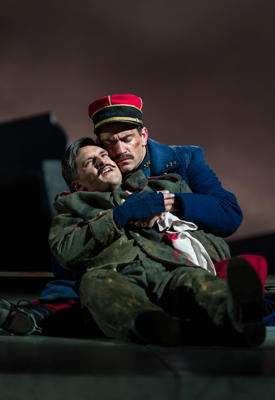
Quirijn de Lang and Matthew Worth in Kevin Puts' 'Silent Night' at Wexford Festival Opera. Photo © 2014 Clive Barda. Click on the image for higher resolution
|
Matthew Worth sang the key role of Lieutenant Audebert with a pliable, generous baritone. As his father (and commander), Scott Wilde's General was a perfect foil, blustery, solid and vocally imposing. The corresponding German Kommandant, Lieutenant Horstmayer, also known as Philip Horst, was possessed of a searing Heldenbariton that was one of the night's most memorable vocal achievements. As the (eventually) vengeful Scot lad Jonathan, Alexander Sprague's commitment to the heat of a few moments found him pushing his accomplished lyric tenor out of his comfort zone, but always in committed service to the drama. All the remaining soloists contributed seamlessly to the evening, and the thrilling ensemble work, which included layering of solo lines, was nothing short of astonishing.
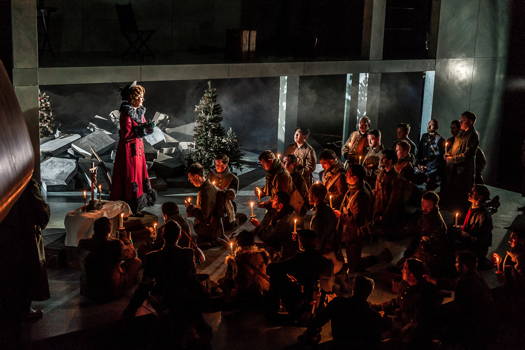
Sinead Mulhern and the cast of Kevin Puts' 'Silent Night' at Wexford Festival Opera. Photo © 2014 Clive Barda. Click on the image for higher resolution
|
The first act ends with great impact as the troops mutually agree upon a Christmas truce. They intermingle uneasily at first, then more hopefully, eventually holding aloft lighted matches in a stirring stage picture, until the distant sounds of shelling compromise the momentary joy of the season. The moment was so moving, so honest, so 'right', that as the intermission began, I seriously thought Silent Night could have ended perfectly right then and there.
We know where the second act has to be rather anti-climactically headed, and although the composer and librettist have conceived some subsequent lovely scenes and ever intriguing music, the piece never again quite achieved the poignancy of that magical moment of reconciliation at the end of Act One. In the end, I was grateful for the many riches in the first class treatment of this important piece. I was well and truly touched. But I had wanted to be unutterably changed.
In addition to the main stage fare, there were afternoons of short works on display, staged with piano, in the ballroom of White's of Wexford Hotel. The first of these featured The Wandering Scholar and Trial by Jury in a charming hour-long pairing. Playing the willingly wayward wife Alison in the former, Chloe Morgan was lovely to behold and her crystalline soprano foretold a potentially fine Susanna someday sooner rather than later. At this point in her development as a performer, Morgan was not always dramatically engaged, going through well-schooled moves but without an inner motivation. Gavan Ring appeared a bit young for the serial lecher Father Philippe, but he mined great detail out of the horny priest's intentions. Ring's assured singing was well-schooled and freely produced. His imposing outbursts gave much more pleasure than his character got in return.
As the scholar, Peter Davoren's Pierre once again showed that he had a beautiful core to his lyric tenor, but he pulls the placement back on the top, clinging to held notes with more determination than ease. Young Jamie Rock was a delight as the husband Louis, performing with coltish animation and charming us with an infectiously appealing lyric baritone.
Conor Hanratty staged the piece cleverly, incorporating all the must-do business, but the treatment of the 'pork in the pot' remained a mystery. Although the text includes questions concerning the cooking time for the meat, there was no suggestion of stove. The pot seems to move from cupboard to table with more references about how long it will take to finish cooking it. A bit more attention to detail would not be amiss as bits like this take us out of the moment.
Trial by Jury was a musically tight, no-nonsense presentation that landed all of the jokes and rendered the satire with cheeky aplomb. Nicholas Morris brought a wealth of experience to bear as 'The Learned Judge' who knew not only how to send waves of mellifluous tone floating out over the crowd, but shrewdly colored his comic lines for maximum impact.
Ashley Mercer's Usher was lanky and lean, as was his somewhat dry baritone that was perhaps one size too small to ride the assemblage with cries of 'Silence in the Court'. Nonetheless, Mercer's comic sense was admirable. Riccardo Iannello (Defendant) was unrepentantly fickle, his slightly compromised tenor negotiating all that was required. His consistent stage presence, loose limbed and shameless, merited his laughs. Johane Ansell (The Plaintiff) has a sizable, womanly soprano whose arching lines provided a nice balance to the silliness going on around her. Ryan Ross (Council for the Plaintiff) ably embodied the lawyer, but his tonal production lost placement a few times and the line got interrupted.
Conor Hanratty's staging here was just right, busy without being breathless, and an amazing number of different of stage pictures were achieved. As well executed as it was at the premiere, more shows will bring even greater precision to the routine. At the keyboard, Janet Haney provided inspired musical direction.
The next day, Il Tabarro was quite well realized although playing verismo in such a small space with such proximity to the audience, there is little room for error. In that context, Director Dafydd Williams' actors were executing well-crafted blocking rather than truly connecting on a visceral and sexual level. The placement of singers was good but somehow seemed too clean, too controlled. The Grand Guignol element was in short supply and was seriously compromised by having Michele pointing to Luigi's body 'over there' under a cape rather than sadistically pulling Giorgietta into the final embrace with her dead lover.
Quentin Hayes certainly has the right maturity and polish of sound for Michele, even if he was (just) a bit short on the very top. Maria Kozlova's Giorgietta was ample of voice, and had a reliable top including a fine High C, but she lacked the final sultry allure that can make this part leap off the page. As Luigi, handsome Alexandros Tsilogiannis has the proper squillo that this part needs and he sang commendably throughout.
I liked Andrew Tipple's appealing, grainy bass that served Talpa well. As Tinca, Stuart Laing has the clearest, freshest tenor voice I (or anyone) have ever heard in this part. La Frugola was assumed by Kezia Bienek with her bright, forward mezzo complete with a somewhat rapid vibrato that had great, personalized character. The roles of the Song Seller/Lover were well taken by an appealing young tenor David Lynn, who only needs to even out his sense of line. Alice Rose Privett's Female Lover seemed a less experienced soprano, although she managed to make the most of an interesting directorial bit that revealed her to be a prostitute whom the lad pays off before exiting.
The production had many assets, like staging the actors' entrances through the audience, creating a good environment. The ship was suggested well with some angled crates stage right balanced by a laundry line stage left laden with clothing. Once it was unburdened the rope was taken down to be available later to strangle Luigi. Michele's sobbed 'sgualdrina' was a good touch, not the usual hurled invective. In spite of severe limitations, or perhaps because of them, John Crudden's lighting design was masterfully done, suggesting a haunting sunset and then the encroaching darkness so critical to the atmosphere. Pianist/Music Director Andrea Grant was virtuosic in conveying the colors and power of the piano reduction, especially when suggesting the undulating flow of the Seine.
Copyright © 1 November 2014
James Sohre,
Nevada, USA

63rd Wexford Festival Opera
at Wexford Opera House, County Wexford, Ireland
22 October - 2 November 2014
(reviewed performances: 22, 23 and 24 October 2014) Antoine Mariotte: Salomé Salomé: Na'ama Goldman; Iokanaan: Igor Golovatenko; Hérode: Scott Wilde; Hérodias: Nora Sourouzian; Young Syrian (Narraboth): Eamonn Mulhall; Page of Hérodias: Emma Watkinson; First Soldier: Nicholas Morris; Second Soldier: Jorge Navarro-Colorado; Naaman: Ian Gerard White; Conductor: David Angus; Director: Rosetta Cucchi; Set Design: Tiziano Santi; Costume Design: Claudia Pernigotti; Lighting Design: DM Wood; Choreography: Vittorio Colella Antonio Cagnoni: Don Bucefalo Don Bucefalo: Filippo Fontana; Rosa: Marie-Eve Munger; Count di Belprato: Matthew Newlin; Agata: Jennifer Davis; Gianetta: Kezia Bienek; Carlino: Peter Davoren; Don Marco: Davide Bartolucci; Conductor: Sergio Alapont; Director: Kevin Newbury; Set Design: Victoria (Vita) Tzykun; Costume Design: Jessica Jahn; Lighting Design: DM Wood; Choreography: Paula O'Reilly Kevin Puts: Silent Night Nikolaus Sprink: Chad Johnson; Anna Sørensen: Sinéad Mulhern; Lieutenant Horstmayer: Philip Horst; Kronprinz: Alexandros Tsilogiannis; Jonathan Dale: Alexander Sprague; William Dale: Ian Beadle; Father Palmer: Quentin Hayes; Lieutenant Gordon: Gavan Ring; British Major: Koji Terada; Lieutenant Audebert: Matthew Worth; Ponchel: Quirijn de Lang; General: Scott Wilde; Madeleine Audebert: Kate Allen; Gueusselin: Jamie Rock; Conductor: Michael Christie; Director: Tomer Zvulun; Set Design: Erhard Rom; Costume Design: Victoria (Vita) Tzykun; Lighting Design: DM Wood Gustav Holst: The Wandering Scholar Pierre: Peter Davoren; Father Philippe: Gavan Ring; Louis: Jamie Rock; Alison: Chloe Morgan; Music Director: Janet Haney; Director: Conor Hanratty; Lighting Design: John Crudden Arthur Sullivan: Trial by Jury The Learned Judge: Nicholas Morris; The Plaintiff: Johane Ansell; The Defendant: Riccardo Iannello; Council for the Plaintiff: Ryan Ross; Usher: Ashley Mercer; Foreman of the Jury: Koji Terada; First Bridesmaid: Jennifer Davis; Bridesmaid 1: Rachel Croash; Bridesmaid 2: Chloe Morgan; Bridesmaid 3: Leila Moreso; Bridesmaid 4: Natalie Sinnott; Gentleman of the Jury 1: Richard Shaffrey; Gentleman of the Jury 2: Richard Hansen; Gentleman of the Jury 3: David Howes; Gentleman of the Jury 4: Matthew Wright; Music Director: Janet Haney; Director: Conor Hanratty; Lighting Design: John Crudden Giacomo Puccini: Il Tabarro Michele: Quentin Hayes; Giorgetta: Maria Kozlova; Luigi: Alexandros Tsilogiannis; Tinca: Stuart Laing; Talpa: Andrew Tipple; Il frugola: Kezia Bienek; Stevedore: Stefan Berkieta; Stevedore/Solo Tenor: David Lynn; Midnete/Female Lover: Alice Rose Privett; Music Director: Andrea Grant; Director: Dafydd Williams; Lighting Design: John Crudden; Costume Supervisor: Frances White |
|

